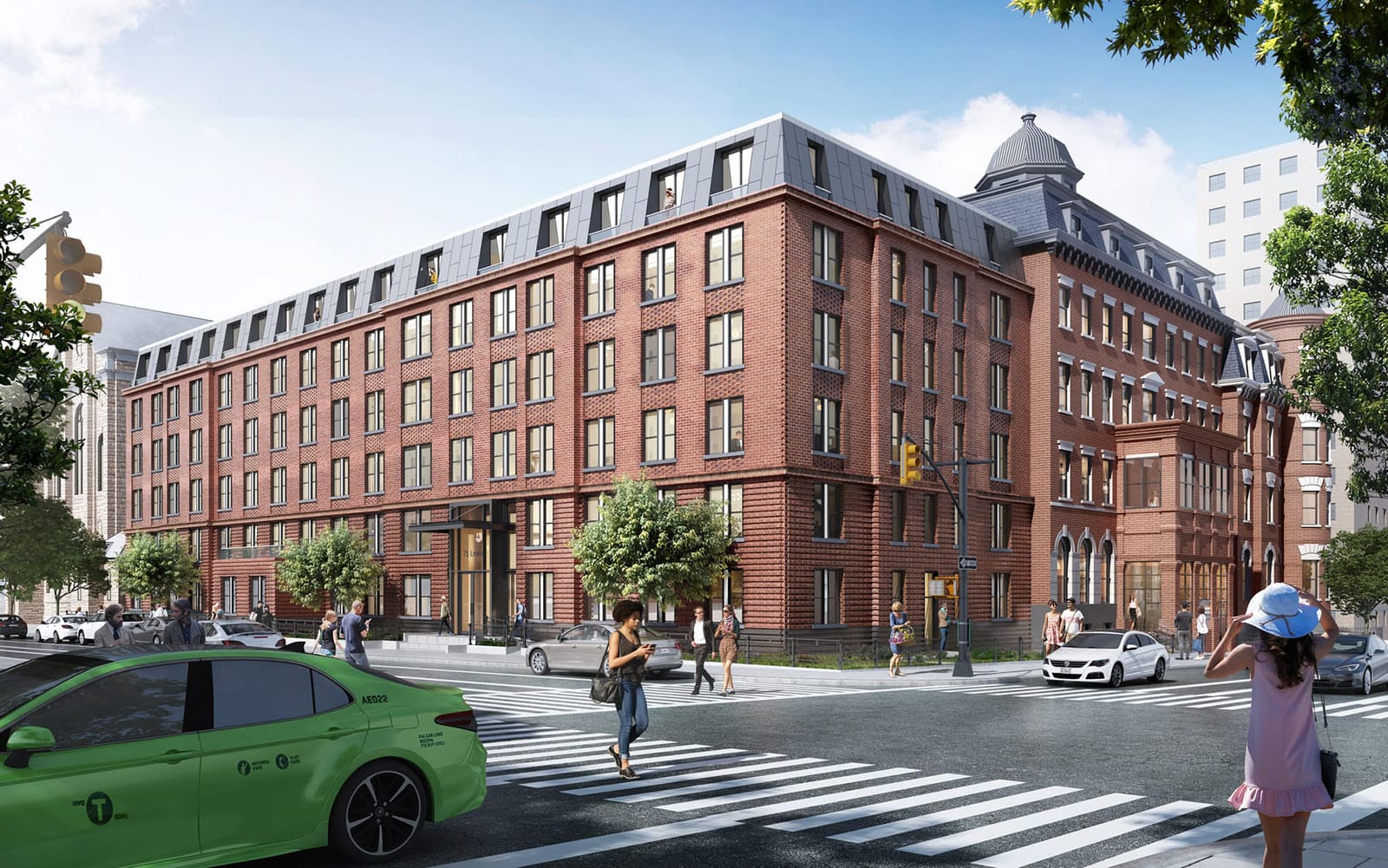Policy
This Missing Middle Adaptive Reuse Project Can Play In Peoria
Missing middle housing advocates focus on new construction but give little attention to how repurposing existing buildings can be a solution. A redevelopment of an old college building in New York City's Brooklyn offers an example of how it can be done.

Discussions about creating missing middle housing to solve the housing shortage focus mainly on new construction in neighborhoods zoned strictly for single-family housing.
Changing minds has proved challenging when convincing cities to allow added density in those neighborhoods.
Little attention has been given to how repurposing buildings for residential use can add to the missing middle stock, especially in urban environs that have a provision for density in the first place.
A new development in Brooklyn shines as an example of how it can be done. Still, the project also reveals the challenges of converting even small buildings to residential. The Hartby, a 205-unit apartment adaptive reuse of a former college building, blends new construction with old.
Of the total, 62 affordable units are reserved for people earning 130% of area median income. Future renters entered a lottery to land a unit.
“We had close to 25,000 applicants for those 62 units,” said Matt Linde, CEO of Property Resources Corp., which redeveloped the building with Avenue Realty Capital.
New York City has a well-documented problem with affordable housing. The metropolitan area has led the country in apartment construction for several years but still can’t catch up.
Headline after headline noted the metro’s population loss during the pandemic. New York City’s vacancy rate rose to 4.5% in 2021 and then tightened to 1.4% in 2023, the lowest in 50 years, according to a New York City Comptroller report. Vacancy now is 3.2% for the entire metro.
Financing the Deal
Office-to-residential conversions are the rage now because of underused office buildings. But the projects tend to be large with hundreds of units and neighbor other towering buildings.
Brownstone homes surround The Hartby. A smattering of apartment buildings also dot the neighborhood. Some are larger. But all fit within the old neighborhood scale featuring various sizes that middle missing housing advocates support.
The building was constructed in the late 1800s to house the College of St. John the Baptist, today known as St. John’s University. St. John’s moved to Queens in the mid-1950s and the building was used for various purposes. It was empty and deteriorating when the developers secured the deal.
They paid $14.2 million for the ground lease that doesn’t expire until 2067. The Roman Catholic Church owns the dirt underneath the building and neighboring St. John’s the Baptist Roman Catholic Church.
To get the deal to work financially, the developers tapped into New York City’s 421-a Tax Incentive program for tax abatements because of the affordable units.
At 130% of AMI, the project worked financially without state and federal tax credits, Linde said. He noted that projects targeting 100% or below AMI don’t “pencil” without local, state or federal subsidies.
“New York's a really interesting place to do business, because there's lots of different sources of capital,” Linde added. “There's lots of funding for different types of grants and subsidies, as long as you follow the rules. But it's a challenge because there's a lot of bureaucracy. The projects take a really long time to get all the approvals you need to get that sort of subsidy. And meanwhile, the disconnect between the demand for housing and the supply of housing continues to grow wider.”
Dealing with Challenges
Like many adaptive reuse projects, there’s always the risk of the unknown. In The Hartby’s case, it was getting parking for the apartments.
Converting from a school to residential meant triggering a zoning requirement for parking. The building was landlocked and there was nowhere to put parking. A previous developer was unsuccessful in obtaining a variance.
Linde said the requirement was one parking space per two apartments. There had been changes to the city organization approving variances, but Linde said the process was dragging and taking forever.
The church still had a say in what could be done with the building. Linde said they told the church that “we think we can get this done, but the only way to put parking on this site is to dig and to do it below the building.” And the church agreed.
Two of the four buildings on the site were demolished. But another problem arose when they started digging for the parking. The existing building started to move, and they had to stabilize the soil underneath it.
It wasn’t so much the cost of doing it but the time in doing it—loan interest and ground lease payments.
“We probably lost six to nine months in kind of stopping construction and filling the ground with soil, but thankfully, the project was able to absorb it,” Linde said.
A seven-story new portion was built alongside the remaining buildings. Architecture firm Woods Bagot handled the design work to make the new portion look similar to the existing portion.
“There were definitely some sleepless nights,” Linde said of getting the project across the finish line. “You kind of always got to be prepared for surprises, for sure.”
MORE IN Policy
Texas Treads A New Path Into Zoning To Battle Housing Crisis
Texas is one of the nation's most active homebuilding states, yet affordability slips out of reach for millions. Lawmakers now aim to rewire the state’s zoning laws to boost supply, speed up approvals, and limit local obstruction. We unpack three key bills and the stakes behind them.
Together On Fixing Housing: Solve Two, Start the Rest
NAHB Chief Economist Robert Dietz and Lennar Mortgage President Laura Escobar argue that the housing crisis won’t be solved by magic. It starts with a unified focus on two or three priorities—a rallying cry for builders, developers, lenders, and policy-makers.
Zone Offense: North Carolina Moves To Fast-Track By Right Housing
North Carolina legislators are pushing a bipartisan bill that could fast-track housing where people need it most: near jobs and transit. Richard Lawson breaks down what it means, how it compares to other states’ moves, and why developers are watching closely.
